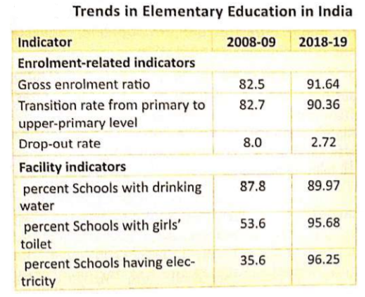

- With rapid economic growth and social development in the last few decades, India has witnessed considerable improvements in health and education as well as falling poverty rates.
Social Security and Education
- Education is considered as the backbone of development and is recognised as one of the most important instruments to alleviate poverty and reduce inequality.
- It can guarantee social security with ripple effects across other critical dimensions of human development, through its correlation with Improvements in health, strengthening the democracy and ensuring good governance.
Programmes
1. Mid-Day Meals
- Classroom hunger irrefutably impacts learning. A hungry child is less likely to attend school and is more susceptible to illnesses.
- Simultaneously addressing food security and education, the scheme helps children from disadvantaged communities to collectively combat hunger, poverty and illiteracy.
- The objective of the school meals programme is to boost efforts to universalise education by increasing enrolment, retention and attendance while improving nutritional levels among children.
2. The Integrated Child Development Services
- It was launched in 1975 in pursuance of the National Policy for Children. It provides nutrition, health and pre-school education to children under the age of six through child care centres or anganwadis staffed by local women workers or helpers. These centres offer food, games and regular health check-ups.
3. Sarva Shiksha Abhiyan
- The programme supported the setting up of new schools in habitations that did not have schooling facilities and the provision of additional classrooms, toilets, drinking water, maintenance and school improvement grants.
- It also focused strengthening teaching resources through extensive training, grants for developing teaching learning materials and ensuring academic support at the district, block and even cluster level.
- Aiming to treat the school education space from prenursery to Class 12th holistically as a continuum, the Government subsumed the SSA for elementary education, the Rashtriya Madhyamik Shiksha Abhiyan (RMSA) for secondary education, and the scheme for Teacher Education into the Samagra Shiksha scheme, catering to ail 25 school students.
4. The Right to Education
- The Right to Education is directly linked to the Right to Life under the Indian Constitution.
- In addition to free and compulsory education, The RTE also requires a pupil-teacher ratio of 30:1 for every primary school and 35:1 for every upper primary school.
5. Draft National Education Policy
- The NEP aims to provide early childhood care and education for all children aged 3-6 by 2025; ensure universal access and retention across all levels of school education and 100 percent youth and adult literacy by 2030.
- Further, it calls for placing the students and teachers at the centre of all reforms, improving school governance, expanding the Mid-Day Meal programme and strengthening the Right to Education.
- Its effective implementation is imperative to strengthen the extant social security measures.
6. Aatmanirbhar Bharat Abhiyan
- Education has been identified as one of the core sectors with the main post-COVID theme of 'technology-driven education with equity'.
- PM E-Vidya, a programme for multi-mode access to online education will be launched shortly to include facilities to support school education in States/UTs under the Digital Infrastructure for Knowledge Sharing, DIKSHA (one nation, one digital platform) programme. Extensive use of radio and podcasts is being envisioned along with the use of Television.
- Over 200 textbook’, have been added to the digital repository, E-pathshala. The Ministry of Human Resource Development (MHRD) is also working on Manodarpan, an initiative to provide psycho - social support to students and families for mental health and well-being.
- A National Foundational Literacy and Numeracy Mission will be launched so that every child attains pro-defined learning outcomes in Grade 5 by 2025.
Challenges
- The National Sample Survey Office (NSSO), 2014 estimated that 3.2 crore children up to the age of 13 have never attended any school.
- The drop-out rate worsens with grade-progression and at the secondary level it is almost 10 percent.
- Further, quality of education remains a major concern. The Annual Status of Education Report (ASER), 2018, reveals that nearly 50 percent and 27 percent of students in Grade V and Grade VIII, respectively, cannot read a Grade II level textbook.
- Extrapolations from cross-country comparison across diverse countries on human development parameters related to education, also highlights India's relatively lower status of education.
- The Gross enrolment ratio at the primary stages in China is over six times that of India, the expected and mean years of schooling is lower than other countries with starker differences for females; the share of government expenditure on education is also lesser.
- Norway, with the highest score in the United Nations Education Index, spends twice as much as India in terms of the percentage allocation of its Gross Domestic Product (GDP).
Way Forward
- While the record of social security measures in education varies between States, there is a large pool of evidence suggestive of its important contribution to human welfare.
- It is hoped that extant debates on enhancing social security such as universalisation vs. targeting continue to contribute to efforts to augment the foundations of social protection in India.
- Addressing challenges to social security through education requires action on three fronts:
- First is the need to address the fiscal challenge.
- Second, the design and dimensions of various schemes need to be carefully re-examined and evaluated, along with a scoping exercise detailing necessary course corrections.
- Third, there is significant potential to increase implementation efficacy through enhanced accountability and pro-active measures to reach the most vulnerable sections of society.
Related Articles



